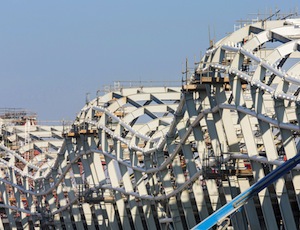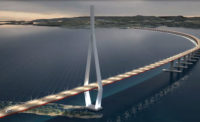
For large international design firms, the past year has been one of uncertainty. Lower oil prices, regional tensions in the Middle East and economic turbulence in Europe have undermined growing demands for infrastructure around the world. And the sharp drop in the Chinese stock market and the Greek debt crisis have given designers two more things to think about.
The impact of the uncertainty in the world market can be seen in the results of ENR’s Top 225 International Design Firms survey. The Top 225 firms generated $70.85 billion in design revenue in 2014 from projects outside their home countries, down 1.1%, from $71.63 billion, in 2013. They also had $73.48 billion in revenue from domestic projects in 2014, up 1.6%, from $72.32 billion, in 2014. The total 2014 design revenue for the group was $144.34 billion, up 0.3%, from $143.95 billion, in 2013.
On the Top 225 International Design Firms list, firms are ranked based on design revenue from projects outside of their home countries, measuring their presence in international commerce. The ENR Top 150 Global Design Firms list measures total worldwide design revenue, regardless of where the projects are located.
On a regional basis, Canada saw one of the biggest drops in international design work for the Top 225, down 15.0% in 2014, as the oil price drop stalled some of Canada’s oil-sands projects. The Latin American market also saw a significant decline, with international revenue falling 18.5% as the economies of Argentina and Brazil experienced slowdowns and the mining sector in Chile was hit hard.
The Asian market, hit by a slowing in China and a market decline in Australia, fell 7.8%. The economic turmoil in the European Union, led by the Greek bailout crisis, caused the Top 225 international designers’ revenue to fall 7.5% in Europe.
Surprisingly, the Middle East market rose 12.0% in 2014 for the Top 225, despite a drop in oil prices and some wariness about whether as this would impact regional investment. The U.S. as an international market surged 43.8% among the Top 225. Part of this rise can be attributed to Canada’s WSP acquiring U.S.-based Parsons Brinckerhoff and Australia’s GHD acquiring Conestoga-Rovers & Associates.
Bigger Is Better
Acquisitions have been a big story in the past year. AECOM now is No. 1 on the Top 225, after acquiring last year’s No. 3 firm, URS Corp. Another big move on the Top 225 is by China’s Power Construction Corp., which consolidated revenue from its operating units, including Hydrochina Corp., to rise to No. 30 from No. 126.
In more acquisition news, ARCADIS grew to 28,000 from 15,000 staff in the past four years largely through several large acquisitions, says Neil McArthur, CEO of Netherlands-based ARCADIS NV. They include the U.K.’s engineering firm Hyder plc, with some 5,000 employees, and large, Seattle-based architect Callison LLC.
European firms are getting bigger. Most recently, the ongoing acquisition by Sweden’s Sweco AB of Netherlands-based Grontmij NV will create a new player with 14,500 employees. After a few years of bad results, Grontmij had “reached a strategic crossroad,” noted firm CEO Michiel Jaski in the acquisition’s announcement this June. Between 2010 and last year, Grontmij’s net sales fell 20%, while its net margins dipped to 0.9% from 4.1%. In that period, staff fell by nearly a third.
Many international design firms say size does matter in the world market. “Firms need to be large enough to straddle various economic cycles and invest in organic growth and technology,” says Uwe Krueger, CEO of WS Atkins plc. With around 18,000 employees, he says, “we don’t feel disadvantaged.”
Atkins is leveraging its size with strategic relationships “by partnering with a select number of contractors,” says Krueger. It started with France’s Vinci Group on the Doha, Qatar, metro. The firm also has an agreement with China Communications Construction Co. Ltd., which is “predominantly geared to large projects in Africa,” according to Krueger.
Some design firms do not see these new megafirms as a direct threat. “Some of our competitors are being bought up by large conglomerates that are focused on large infrastructure and oil-and-gas projects,” says Con Murphy, sector director for Ireland’s PM Group. However, he says this situation has left room in the market for new design firms that provide neither the quality nor the expertise but offer lower prices, which affects pricing for everyone.
Many international designers continue to be wary of price pressure. “One key negative trend that is affecting the international design industry is price-driven selection,” says Andy Goodwin, CEO of Australia’s SMEC. He says this undervalues the design input on a project and results in an inferior project outcome and higher costs over the long term through higher construction and maintenance costs.








Post a comment to this article
Report Abusive Comment